You might’ve landed on our page because you’re a bird enthusiast just looking for fascinating bird facts. Or you might be a homeowner whose garden’s been visited repeatedly by wasps, and you’re wondering whether there’s a natural way to get rid of them. Or, on the contrary, you might be concerned with the wasp population – are any bird species a threat to their existence?
Either way, we’re here with the answers you’ve been looking for! We’ve got eight types of birds that eat wasps. Some picks for our list indicate bird families, while others are concerned with certain species.
As such, if you want to learn about birds specialized in eating wasps, keep reading! We’ve got plenty of incredible facts!
8 Types of Birds That Eat Wasps
While many insectivorous birds occasionally hunt and eat one or two wasps, they aren’t specialized in performing this activity. Since not all birds are used to handling these insects, they can easily get stung or hurt.
Therefore, only a few birds have adaptations specialized in hunting these stinging insects or in checking out their nests. In fact, studies focused on bee-eaters have demonstrated that the more bees and wasps they hunt and kill, the better they are at handling them!
1. Bee-Eaters
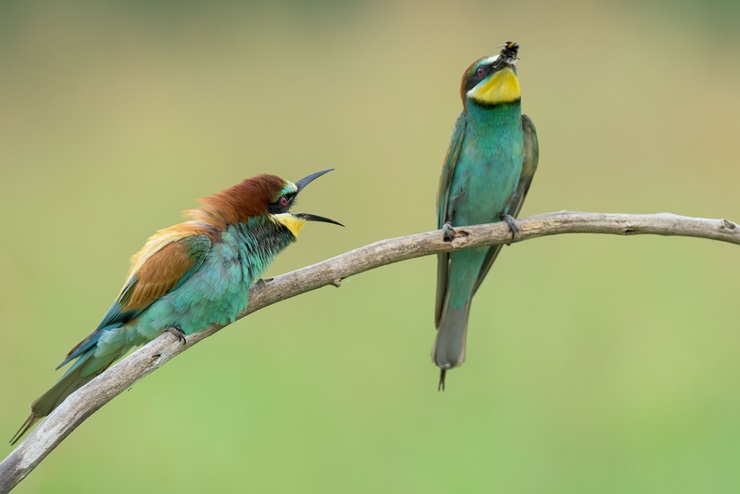
Scientific name: Meropidae (family)
Bee-eaters are part of the Meropidae family of non-passerine birds. They’re widespread throughout Africa and Asia, although some species are now found in Australia, Europe, and New Guinea. These beautiful creatures live in colonies and build their nests in tunneled burrows usually located close to rivers.
As their common name suggests, bee-eaters are experts at eating bees. However, they also prey on wasps! They’ve developed excellent hunting techniques that allow them to spot bees and wasps from afar. The blue-cheeked bee-eater, for example, has been seen spotting large wasps from distances of 100 meters (330 feet)!
Bee-eaters are known to prefer taking flying bees and wasps. If they take on a wasp, they rely on a special technique used to discharge the stinger and the venom sac to avoid being stung. Studies show that this behavior is learned over time.
2. Crested Honey Buzzard
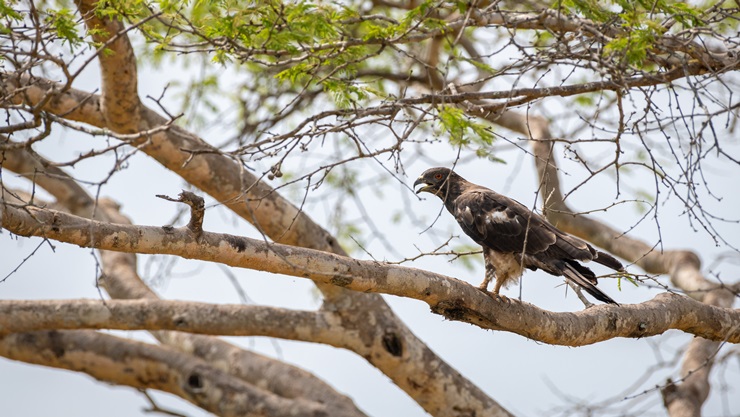
- Scientific name: Pernis ptilorhynchus
- Size: 57–60 cm (22–24 in)
- Weight: 600-1,500 g (21.1-52.9 oz)
- Wingspan: 110-160 cm (43.3-62.9 in)
The crested honey buzzard is scientifically called Pernis ptilorhynchus and is part of the Accipitridae family of birds of prey alongside other raptors like eagles and vultures.
These birds overwinter in tropical Southeast Asia, as well as on the Indian subcontinent. During the summer, they’ve been spotted in Siberia and Japan. The birds living in other regions are considered year-long residents.
Unlike other raptors that prey primarily on mammals, birds, and even carrion, the crested honey buzzard, a medium-sized bird, prefers feeding on the larvae of social bees and wasps. They’re even known to eat honey.
Using their talons, crested honey buzzards dig up the nests of social wasps and rely on their long, slender beaks to forage these nests. Their tongues are specialized in extracting bee and wasp larvae from honeycombs.
Besides having these special adaptations, crested honey buzzards are almost immune to wasp stings, as they’re equipped with unique feathers around their heads and necks that repel the attacks and protect them from wasp venom.
3. Scarlet Tanagers

- Scientific name: Piranga olivacea
- Size: 16-19 cm (6.3-7.5 in)
- Weight: 23.5-38 g (0.83-1.34 oz)
- Wingspan: 25-30 cm (9.8-11.8 in)
Scarlet tanagers are songbirds in the Cardinalidae family of passerine birds alongside grosbeaks and buntings.
They are inhabitants of North and South America. They spend their breeding seasons in eastern-central North America and their winters in South America after engaging in a migration route through Central America. Scarlet tanagers prefer living in deciduous forests but have been spotted in parks, suburban areas, and montane forests.
Unlike the other two species on our list, the scarlet tanager isn’t an expert at hunting, catching, and killing wasps, but it won’t refuse a wasp meal if the opportunity presents itself.
In fact, scarlet tanagers are opportunistic eaters and will feed on almost any insect they stumble upon: bees, wasps, moths, beetles, and leafhoppers, to name a few. They may also eat snails, spiders, and earthworms.
However, although they do not specialize in feeding on wasps only, they’re definitely clever enough to smash the wasps against a branch, thus removing the sting and avoiding being stung.
4. Summer Tanagers
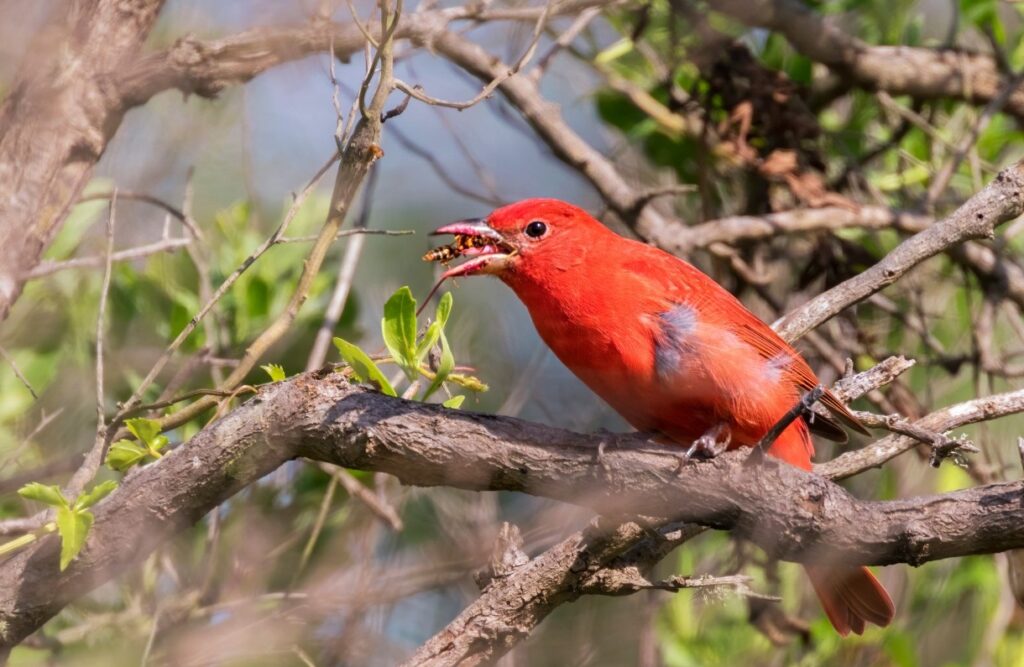
- Scientific name: Piranga rubra
- Size: 17 cm (6.7 in)
- Weight: 29 g (1 oz)
- Wingspan: 28-30 cm (11-11.8 in)
Like its scarlet relative, the summer tanager is part of the Cardinalidae family. These birds spend their breeding season in southern North America, flying towards northern South America for the winter.
These gorgeous birds feed primarily on insects and are known to hunt and catch bees and wasps extensively. Furthermore, like their relatives, summer tanagers also rely on the specialized technique they’ve developed to avoid being stung by wasps – they rake the insects against a branch, thus removing the stingers.
Besides insects, summer tanagers may also occasionally feed on berries, especially the fruits produced by the Cymbopetalum mayanum plant.
5. Great Tits

- Scientific name: Parus major
- Size: 12.5-14 cm (4.9–5.5 in)
- Weight: 11-22 g (0.4-0.8 oz)
- Wingspan: 8 cm (3.2 in)
Great tits are small birds in the Paridae family of passerine birds. They are an abundant species found almost everywhere in the world.
The great tit species is currently divided into 15 recognized subspecies named based on the specimens’ distribution. They’re found in various habitats – open deciduous woodlands, gardens, forest edges, dense and mixed forests, scrublands, and oases.
In the summer, these birds feed primarily on invertebrates. As such, they eat grasshoppers, crickets, cockroaches, earwigs, and flies, to name a few.
Great tits will also prey on bees and wasps if the opportunity arises. When the temperatures drop, however, these small creatures switch to a diet based on berries and seeds because insects aren’t as abundant anymore.
6. Kingbirds
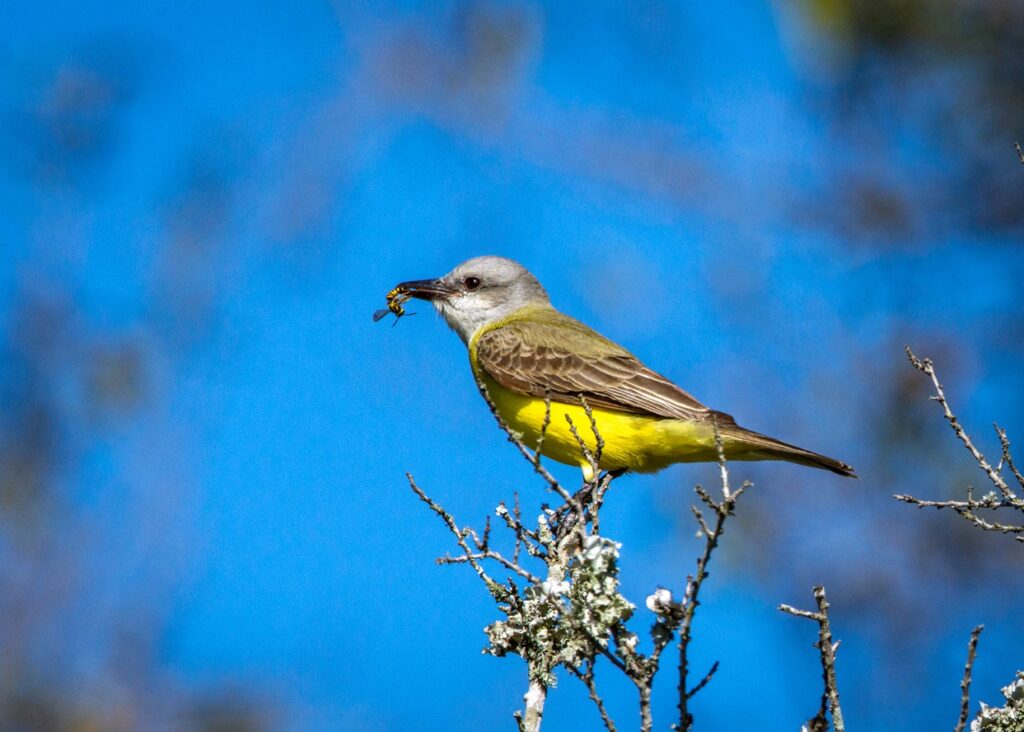
Scientific name: Tyrannus (genus)
The term “kingbird” refers to the 13 bird species in the Tyrannus genus, which are grouped according to their geographic distribution and their appearance. These birds are native to the Americas, living in open or semi-open areas.
They’re known to be quite aggressive when defending their breeding territories and are able to scare away birds much larger than themselves. As such, it’s not a surprise they can take down some stinging wasps!
The tropical kingbird, for instance, is known to catch bees and wasps if the opportunity arises. They also feed on beetles, termites, and moths, and occasionally eat berries and various fruits produced by plants like common guava and gumbo-limbo.
The Couch’s kingbird is another species in the Tyrannus genus that has been observed hunting and feeding on wasps. Like other kingbirds, the Couch’s kingbird is primarily an insectivore but won’t refuse a berry or seed meal.
The same goes for the Gray kingbird, which feeds on wasps, bees, and beetles, among other insects. Additionally, fruits, berries, spiders, and small lizards represent part of their diet.
7. Common Starlings
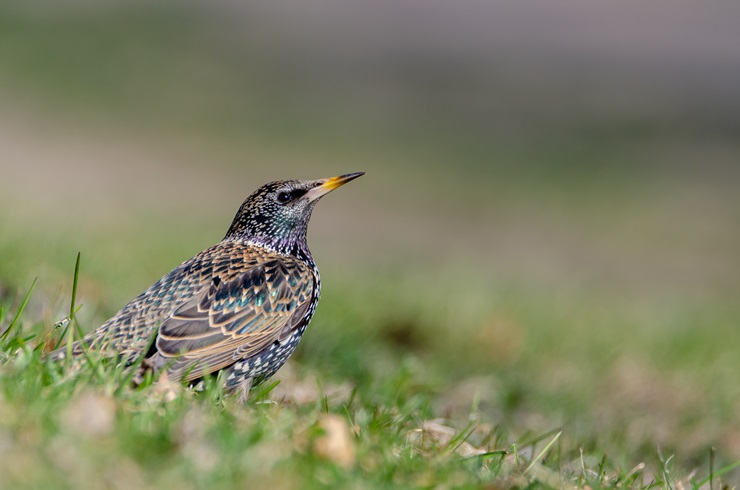
- Scientific name: Sturnus vulgaris
- Size: 9–23 cm (7.5–9.1 in)
- Weight: 58–101 g (2.0–3.6 oz)
- Wingspan: 31–44 cm (12–17 in)
The common starling is often referred to as the European starling. These birds are year-long residents in some parts of the world, including North America, Australia, and Africa, and only summer/winter visitors in other regions.
Like other birds spread worldwide, the common starling is divided into several subspecies grouped according to their geographical distribution. They can also be distinguished by their coloration and appearance, which is affected by their location.
Common starlings are almost exclusively insectivorous but may also eat fruits, seeds, grains, nectar, and even food waste. These birds prefer hunting and eating spiders, moths, mayflies, grasshoppers, as well as bees and wasps. They usually feed close to the ground but sometimes feed in mid-flight, when they hunt and take down prey in flocks.
8. Marsh Wrens
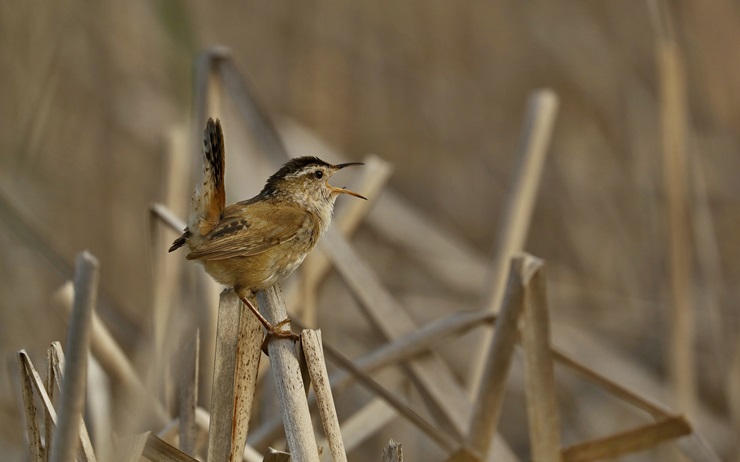
- Scientific name: Cistothorus palustris
- Size: 9.9-14 cm (3.9-5.5 in)
- Weight: 8.5-14.2 g (0.3-0.5 oz)
- Wingspan: 15 cm (5.9 in)
The marsh wren is a small bird native to North America. Some marsh wren populations are year-long residents, while others are migratory, spending their summers in the north and their winters in the south. During the breeding season, marsh wrens build their nests on marsh vegetation.
These small birds are primarily insectivorous but may occasionally delight in spiders or snails. It is known that they usually forage close to water sources. They feed on bugs, caterpillars, beetles, spiders, ants, and wasps. Although they do not excessively feed on wasps like other species on our list, marsh wrens are known to increase their wasp intake during the autumn.
